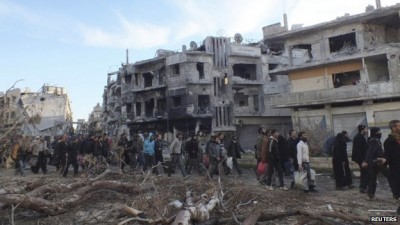
By David Ignatius
The 50th annual Munich Security Conference this month was a celebration of the power of the democratic vision in Europe — one that now stretches all the way toward Ukraine. But there was a sense of defeat in the room, almost of collective shame, when the subject turned to Syria.
The international alliance that won the Cold War has been bootless in the case of Syria. That’s partly the fault of an indecisive Obama administration, but it’s really a much larger problem. The United Nations system for resolving disputes is failing in Syria, as it did in Rwanda, Bosnia and Kosovo. The United States, this time, hasn’t been willing to organize a “coalition of the willing” to do the dirty work.
“Things are bad and getting worse,” said Lakhdar Brahimi, the U.N. envoy for Syria, who seemed near despair as he described the failure last month of his latest mediation effort, known as Geneva II. He is continuing his fraught mediation effort.
The Syria tragedy embodies a deeper intellectual failure. The Cold War was, at bottom, the triumph of an idea. What’s missing in Syria is an animating strategic framework that could power a U.S.-led coalition. Instead, we have a conflict driven by sectarian hatred between Sunni and Shiite Muslims, which in turn is fueled by the rivalry of Saudi Arabia and Iran. Diplomatic efforts are blocked by Russia, which still imagines itself as the United States’ rival.
What to do? In the short run, the United States should step up its training and assistance for the moderate Syrian opposition. This has multiple benefits: A stronger opposition can fight the Bashar al-Assad regime, push back al-Qaida and safeguard humanitarian corridors. This week in Geneva, the opposition proposed a plan for a cease-fire and political transition. That’s a good step forward, but the rebels on their own can’t settle the conflict.
Breaking the Syria deadlock will require a strategy that defuses the sectarian war ravaging the Middle East. I’ve been hearing versions of this approach recently from Obama administration officials, from senior British analysts, from a few farsighted Gulf Arabs and even from Iranians. They all recognize that bridging the Sunni-Shiite schism requires a regional security accord that reconciles the interests of Saudi Arabia and Iran, the engines of the conflict. This regional balance, in turn, requires an understanding between the United States and Russia.
Lebanon offers a lesson in how sectarian conflicts can be stabilized. This may sound paradoxical, given that Beirut always seems a few minutes from chaos. But the Lebanese usually avoid disaster with their compromise formula of “neither victor nor vanquished.” My Lebanon tutorial came in a conversation with Prime Minister Najib Mikati. He explained that the Taif Agreement of 1989, which ended the Lebanese civil war after 15 years, was possible because of two breakthroughs: a regional agreement and U.S.-Russian cooperation. There were many diplomatic false starts along the way — in peace talks at Geneva, Lausanne (in Switzerland) and Cairo. It helped that the Cold War was ending, for until there was consensus at the top, Mikati noted, the Lebanese militias kept fighting.
A surprising public articulation of this approach came in Munich from Iranian Foreign Minister Mohammad Javad Zarif. “Iran and Saudi Arabia share a common interest in a secure environment,” he told the conference. “Neither one of us will benefit from sectarian divisions, neither one of us will benefit from extremism.” It’s hard to take Zarif’s statement at face value when Iran is pumping Hezbollah fighters and Iraqi Shiite militiamen into Syria. But it’s the right concept.
To get Syria right, policymakers should ask themselves what they want the Middle East to look like in five or 10 years, and then reverse-engineer from that model.
A truly stable future will be possible only with a security balance that can accommodate Shiite Iran and the Sunni Gulf states. To be accepted as a regional power, Iran will have to reverse its nuclear program. The Sunni nations, meanwhile, will have to embrace reforms that can break the power of Muslim extremism. This Sunni empowerment will require a new Egyptian president who’s confident enough to stop jailing journalists, and a Saudi Arabia that’s prepared to move ahead under the next generation of leaders. It’s heartening that the Saudis this week stepped away from the jihadists and backed the Syrian opposition’s peace formula.
Here’s a group snapshot of a more stable future: The United States, Russia, Iran and Saudi Arabia sitting around a table to draft a deal that can stop the Syrian nightmare. The Syrians can’t resolve this tragedy without a strong push from above.
WASHINGTON POST
Leave a Reply
You must be logged in to post a comment.